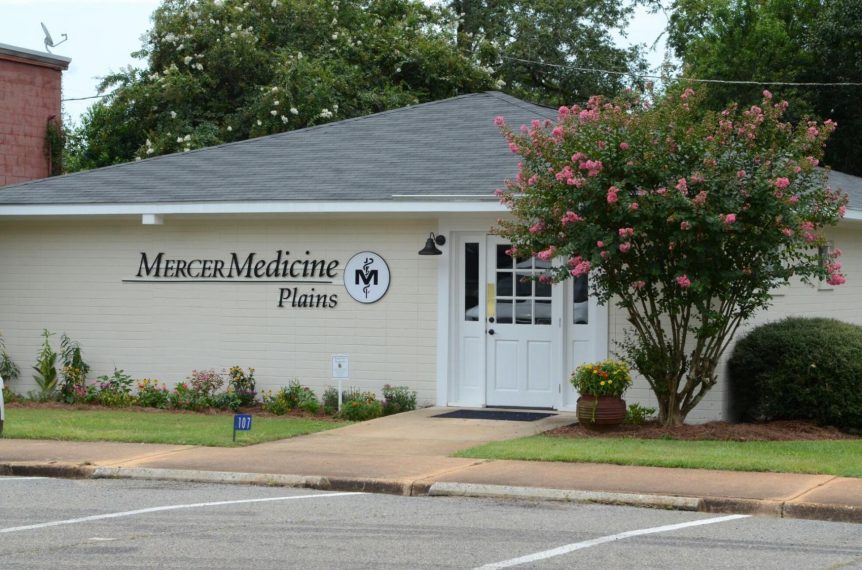PLAINS, GA | By Jennifer Parks | jennifer.parks@albanyherald.com | Updated
Mercer Medicine Plains has remained busy since its opening in downtown Plains earlier this year
Original article can be found at: https://www.albanyherald.com/
____
On the road going into Plains from Albany, there are several cotton fields — a reminder that agriculture is a way of life in the region. As you turn onto Main Street, you see landmarks noting that the tiny Sumter County community is the hometown of former President Jimmy Carter — such as the large red, white and blue sign bearing his name, the Rosalynn Carter Butterfly Trail named for his wife and the former first lady, and the building marking his presidential campaign headquarters.
The downtown is quiet and low-key. Lining the same street is the Plains Historic Inn, a post office and Plains Pharmacy. Next to the post office is Mercer Medicine Plains.
While the Mercer clinic may not look significant on the outside, there is a lot going on inside.
The Carters, Mercer University President William D. Underwood, Mercer University School of Medicine Dean Dr. Jean Sumner and others celebrated earlier this year the opening of the School of Medicine’s new primary care facility in downtown Plains.
“It has been fast and furious,” Mercer Medicine Chief Operating Officer Charles Duffey said during a visit to the clinic this week. “There is such a demand that we have had more difficulty keeping up with the community need than filling up slots.
“We have had to maximize the number of patients we can get in. Usually (with a new clinic like this) it is the inverse of that.”
The former president and first lady hosted representatives from Mercer in May to discuss plans to establish a medical clinic in Plains following the closing of Plains Medical Center in March. The final product of that meeting was the beginning of what Mercer officials said would be a long-term relationship with its southwest Georgia partners.
In July, Mercer Medicine Plains, a division of the faculty practice of Mercer School of Medicine, began accepting patients. With the help of the city of Plains, Mercer officials took a look at the facilities and refurbished them — which meant restocking the rebuilding with both supplies and personnel.
The community involvement in reviving the clinic had an immediate economic impact.
“Patients have expressed how important that was to them,” Duffey said.
At the time of the clinic’s opening, the appointment schedule was quickly filled through October. The clinic offers primary care services using physicians and nurse practitioners as well as specialty care and mental health services.
Care is available Monday through Friday and on Saturday mornings, with a call service providing coverage in the evenings and on weekends. On-site services include primary care, internal medicine, OB/GYN, marriage and family therapy and counseling, and lab and X-ray.
Duffey said the demand has been high enough that, per patient feedback, time was carved into the nurse practitioner’s schedule to specifically address walk-in patients with emergent needs.
“In a small clinic space, you have to be deliberate in how you schedule that,” he said.
Such patient feedback has given insight into what is working and what is not, and in some cases, action has been taken that same day.
“Within a few hours, we were able to make that adjustment (to the nurse practitioner’s schedule),” Duffey said.
Telemedicine technology utilized in the clinic allows additional access to specialties offered at Mercer Medicine in Macon. Training was recently completed on the equipment, and encounters are currently being scheduled — starting with marriage and family therapy services.
The intention for the telemedicine component is for more of Mercer’s services to filter farther south.
“We will be able to have (more) specialty care,” Duffey said.
Duffey said in a city like Macon, there would be two separate facilities — one for urgent care, and another for primary care. The patients coming into the Plains clinic may not have another way to access health care, so the staff there sees both types of cases.
“The biggest surprise has been the support of other communities and other medical facilities that have reached out,” Duffey said. “It speaks to the great need in rural areas in south Georgia.
“They were hungry for this type of model.”
Landscaping outside the clinic includes a butterfly garden that is part of the Rosalynn Carter Butterfly Trail, an effort by the former first lady to inspire the planting of flowers and milkweed to promote the return and migration of the threatened Monarch butterfly population in North America.
The clinic will also serve to educate future health care professionals, as it will have medical students on the site, while pharmacy students will spend time with a pharmacist in the area to further their education.
The staff there is not on an island in Plains, as they have access to Mercer’s resources.
“I think (budding) physicians will see this as a fulfilling opportunity,” Duffey said.
The first medical student is coming in after the first of the year, and an incoming nurse practitioner is finishing up the final stages of her education and will be supervised by the current nurse practitioner. A gynecologist is coming in soon for two half-days a week, and a pediatric surgeon will shortly be seeing patients at the clinic two days a month.
“(This model) has just worked,” Duffey said. “We have not been motivated so much by maximum revenue but (by) providing care to the community. Because of that, a lot of things have fallen into place. There is no doubt that this model has worked and will continue to work.
“We are excited. The attention this clinic has brought to rural health shows there is a way to meet these needs. There is a way to do this and do it well.”
Dr. Michael Raines, a physician at the clinic, said the current setup has been working well for both the staff as well as the patients they care for. He worked at the former clinic that was on the site.
“It’s been going very well,” Raines said. “The patients are very happy to have this center back open. From the staffing standpoint, everyone is very happy with working with Mercer.”
Raines said the facility has been in existence as a medical clinic for about 40 years, and when it was closed, it created a gap in care for patients living in multiple counties. Once it was reopened, patients were appreciative — and were able to notice a strong quality of care.
“(Mercer) has made it very easy to practice the way medicine ought to be practiced,” Raines said. “I am not feeling there is an administrative burden over my head.
“I see there will be a need to expand our center (in the future).”
Raines, like many physicians practicing in a rural area where access is more limited, said he sees the value in bringing in medical students who may one day practice in the same kind of environment. Generally, when they are educated in a particular region, they stay in that region.
“There are a lot of rewards to (practicing) primary care in a rural area,” he said. “I think medical students need to understand the physician-patient relationship. They see you on the street, see you in the stores and do not hesitate to ask you for advice.”
Another goal of bringing students into rural medicine is to dispel the myth that physicians who do not practice in an urban setting are unable to make a successful living. Both Raines and Duffey affirmed that practicing in a rural setting can be beneficial and lead to a sustainable income.
“You have to look at what is a successful career,” Duffey said.
Raines added that a rural primary care doctor ought to be able to do a wide variety of things. It is a big challenge because a primary care physician in a rural area may not be able to immediately rely on a specialty referral to help a patient.
“You should be able to do the gamut,” he said. “It makes you think. It makes you broaden your knowledge base. Can I take care of it, or does (the patient) need to see a specialist?’”
A collection of data after the six-month mark will pinpoint the needs not yet identified and how the clinic is impacting overall wellness. Results might tell Mercer officials where to go next in terms of service expansion and outreach.
It has not been six months yet, but officials say they feel confident of the model’s success.
“I think this model, we could place anywhere,” Duffey said. “All indicators are that this is something (that will be sustainable). We would like to do this again, and we are already starting to scout areas that are underserved.”
Without easy access to care, people often have to travel hours. If a clinic is right down the street, it is more likely they will seek out health care. As part of data collection process, Mercer officials have been talking to families in Plains to measure the kind of improvement they are seeing due to the increased access.
“Community involvement and support is critical for the success of this model,” Duffey said. “(Without the feedback) we can’t develop the kind of clinic the community needs. We are trying to develop personal relationships with patients.”
Mercer University’s School of Medicine was established in 1982 to educate physicians and health professionals to meet the needs of rural and medically underserved areas of Georgia. Today, more than 60 percent of graduates practice in the state, and of those, more than 80 percent are practicing in rural or medically underserved areas.
The clinic is located at 107 Main St. in Plains.
Share this Post













